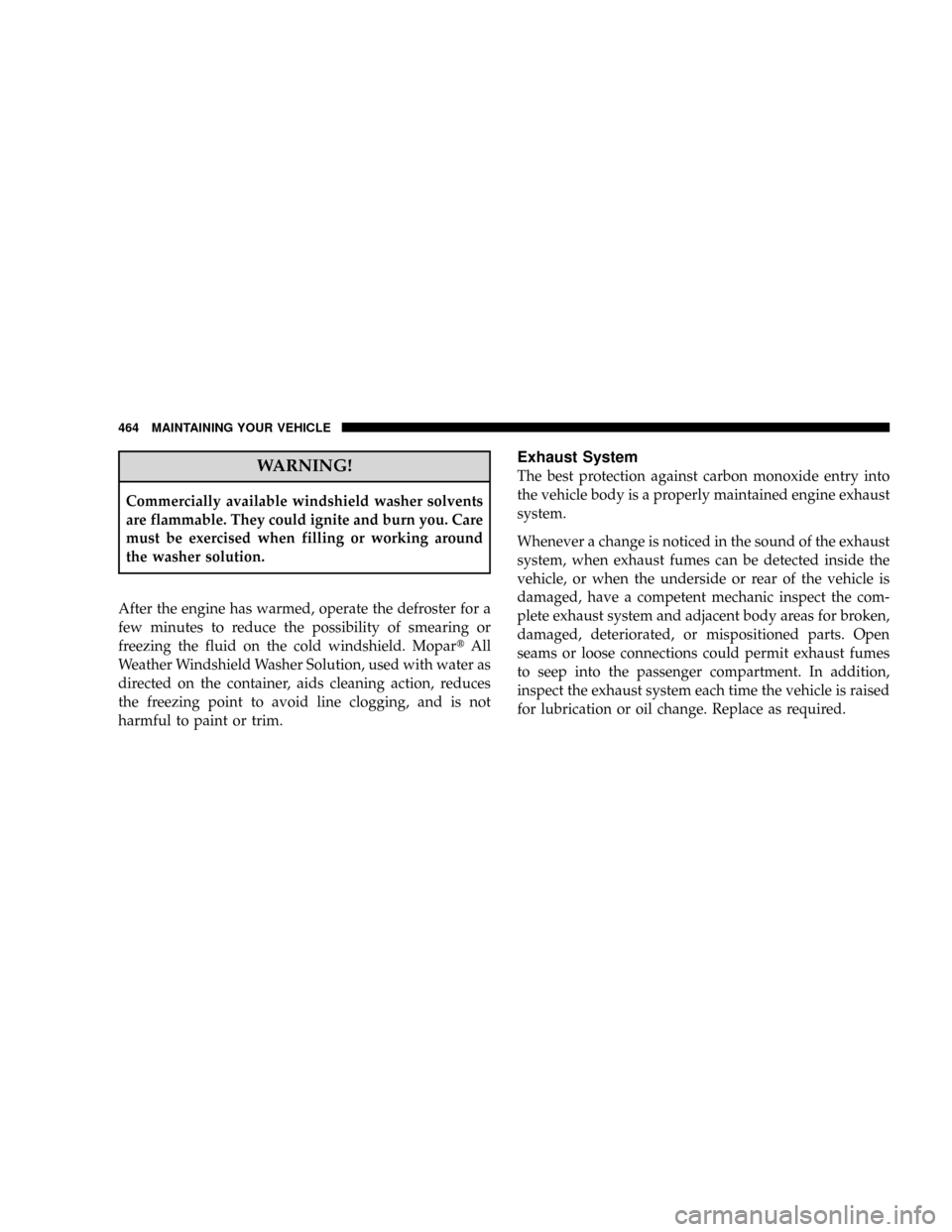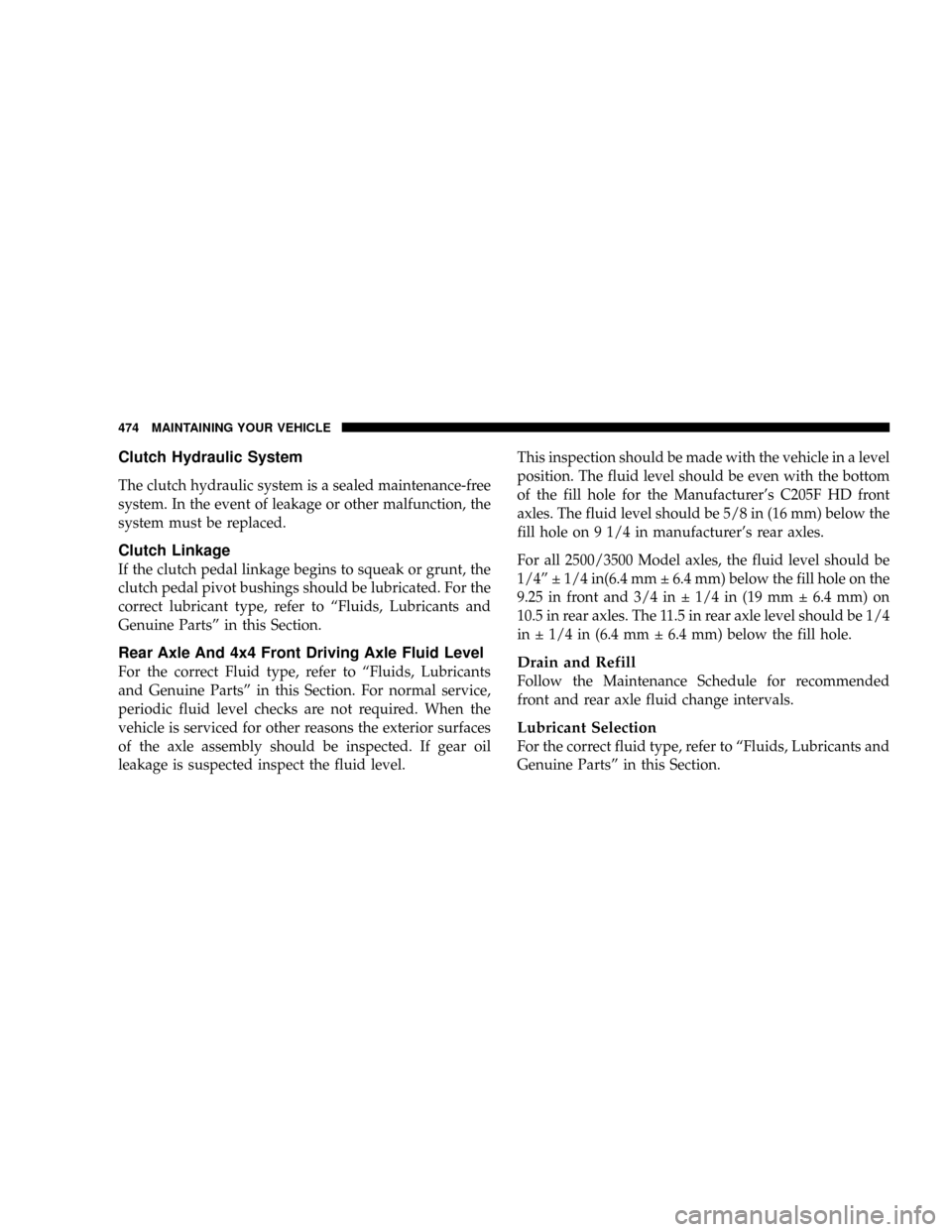Page 464 of 554

Front Prop Shaft Lubrication Ð 2500/3500 (4X4)
Models
Lubricate the front driveshaft grease fitting at each oil
change listed in the appropriate Maintenance Schedule
for your vehicle. Use Moparttype MS-6560 (lithium-
based grease), or equivalent.
Body Lubrication
Locks and all body pivot points, including such items as
seat tracks, doors, liftgate, tailgate, sliding doors and
hood hinges, should be lubricated periodically to assure
quiet, easy operation and to protect against rust and
wear. Prior to the application of any lubricant, the parts
concerned should be wiped clean to remove dust and
grit. After lubricating, excess oil and grease should be
removed. Particular attention should also be given to
hood latching components to ensure proper function.
When performing other underhood services, the hood
latch, release mechanism and safety catch should be
cleaned and lubricated. The external lock cylinders
should be lubricated twice a year, preferably in the Fall
and Spring. Apply a small amount of a high-quality
lubricant such as MopartLock Cylinder Lubricant di-
rectly into the lock cylinder.
Front Driveshaft Grease Fitting
462 MAINTAINING YOUR VEHICLE
Page 465 of 554

Windshield Wiper Blades
The rubber edges of the wiper blades and the windshield
should be cleaned periodically with a sponge or soft cloth
and a mild nonabrasive cleaner. This will remove accu-
mulations of salt or road film.
Operation of the wipers on dry glass for long periods
may cause deterioration of the wiper blades. Always use
washer fluid when using the wipers to remove salt or dirt
from a dry windshield.
Avoid using the wiper blades to remove frost or ice from
the windshield. Keep the blade rubber out of contact with
petroleum products such as engine oil, gasoline, etc.
Windshield Washers
The fluid reservoir is located under the hood and should
be checked for fluid level at regular intervals. Fill thereservoir with windshield washer solvent only (not ra-
diator antifreeze). When refilling the washer fluid reser-
voir, take some washer fluid and apply it to a cloth or
towel and wipe clean the wiper blades, this will help
blade performance.
To prevent freeze-up of your windshield washer system
in cold weather, select a solution or mixture that meets or
exceeds the temperature range of your climate. This
rating information can be found on most washer fluid
containers.
The washer fluid reservoir will hold a full gallon of fluid
when the Low Washer Fluid Light illuminates.
MAINTAINING YOUR VEHICLE 463
7
Page 466 of 554

WARNING!
Commercially available windshield washer solvents
are flammable. They could ignite and burn you. Care
must be exercised when filling or working around
the washer solution.
After the engine has warmed, operate the defroster for a
few minutes to reduce the possibility of smearing or
freezing the fluid on the cold windshield. MopartAll
Weather Windshield Washer Solution, used with water as
directed on the container, aids cleaning action, reduces
the freezing point to avoid line clogging, and is not
harmful to paint or trim.
Exhaust System
The best protection against carbon monoxide entry into
the vehicle body is a properly maintained engine exhaust
system.
Whenever a change is noticed in the sound of the exhaust
system, when exhaust fumes can be detected inside the
vehicle, or when the underside or rear of the vehicle is
damaged, have a competent mechanic inspect the com-
plete exhaust system and adjacent body areas for broken,
damaged, deteriorated, or mispositioned parts. Open
seams or loose connections could permit exhaust fumes
to seep into the passenger compartment. In addition,
inspect the exhaust system each time the vehicle is raised
for lubrication or oil change. Replace as required.
464 MAINTAINING YOUR VEHICLE
Page 474 of 554

Inspect all hose connections such as clamps and cou-
plings to make sure they are secure and no leaks are
present.
NOTE:Often, fluid such as oil, power steering fluid,
and brake fluid are used during assembly plant opera-
tions to facilitate the assembly of hoses to couplings.
Therefore, oil wetness at the hose-coupling area is not
necessarily an indication of leakage. Actual dripping of
hot fluid when systems are under pressure (during
vehicle operation), should be noted before hose is re-
placed based on leakage.
NOTE:Inspection of brake hoses should be performed
whenever the brake system is serviced and every engine
oil change. Inspect hydraulic brake hoses for surface
cracking, scuffing, or worn spots. If there is any evidence
of cracking, scuffing, or worn spots, the hose should be
replaced immediately! Eventual deterioration of the hose
can take place resulting in a possibility of a burst failure.WARNING!
Worn brake hoses can burst and cause brake failure.
You could have an accident. If you see any signs of
cracking, scuffing, or worn spots, have the brake
hoses replaced immediately.
Brake Master Cylinder Ð Brake Fluid Level Check
The fluid level of the master cylinder should be checked
when performing under the hood service, or immedi-
ately if the brake system warning lamp indicates system
failure.
The brake master cylinder has a translucent plastic
reservoir. On the outboard side of the reservoir, there is a
ªMAXº dot and an ªMINº dot. The fluid level must be
kept within these two dots. Do not add fluid above the
MAX mark, because leakage may occur at the cap.
472 MAINTAINING YOUR VEHICLE
Page 475 of 554
With disc brakes the fluid level can be expected to fall as
the brake linings wear. However, an unexpected drop in
fluid level may be caused by a leak and a system check
should be conducted.
For correct fluid type, refer to ºBrake Master Cylinderº
under ªFluids, Lubricants and Genuine Partsº in this
section.
WARNING!
Use of a brake fluid that may have a lower initial
boiling point, or is unidentified as to specification,
may result in sudden brake failure during hard
prolonged braking. You could have an accident.
WARNING!
Overfilling the brake fluid reservoir can result in
spilling brake fluid on hot engine parts and the
brake fluid catching fire.
Use only brake fluid that has been in a tightly-closed
container to avoid contamination from foreign matter or
moisture.
CAUTION!
Do not allow a petroleum-base fluid to contaminate
the brake fluid. Seal damage may result.
MAINTAINING YOUR VEHICLE 473
7
Page 476 of 554

Clutch Hydraulic System
The clutch hydraulic system is a sealed maintenance-free
system. In the event of leakage or other malfunction, the
system must be replaced.
Clutch Linkage
If the clutch pedal linkage begins to squeak or grunt, the
clutch pedal pivot bushings should be lubricated. For the
correct lubricant type, refer to ªFluids, Lubricants and
Genuine Partsº in this Section.
Rear Axle And 4x4 Front Driving Axle Fluid Level
For the correct Fluid type, refer to ªFluids, Lubricants
and Genuine Partsº in this Section. For normal service,
periodic fluid level checks are not required. When the
vehicle is serviced for other reasons the exterior surfaces
of the axle assembly should be inspected. If gear oil
leakage is suspected inspect the fluid level.This inspection should be made with the vehicle in a level
position. The fluid level should be even with the bottom
of the fill hole for the Manufacturer's C205F HD front
axles. The fluid level should be 5/8 in (16 mm) below the
fill hole on 9 1/4 in manufacturer's rear axles.
For all 2500/3500 Model axles, the fluid level should be
1/4º 1/4 in(6.4 mm 6.4 mm) below the fill hole on the
9.25 in front and 3/4 in 1/4 in (19 mm 6.4 mm) on
10.5 in rear axles. The 11.5 in rear axle level should be 1/4
in 1/4 in (6.4 mm 6.4 mm) below the fill hole.Drain and Refill
Follow the Maintenance Schedule for recommended
front and rear axle fluid change intervals.
Lubricant Selection
For the correct fluid type, refer to ªFluids, Lubricants and
Genuine Partsº in this Section.
474 MAINTAINING YOUR VEHICLE
Page 477 of 554

NOTE:The presence of water in the gear lubricant will
result in corrosion and possible failure of differential
components. Operation of the vehicle in water, as may be
encountered in some off-highway types of service, will
require draining and refilling the axle to avoid damage.
Limited-Slip Differentialsin 1500 Model vehicles re-
quire that 4 oz. (118 ml) Mopartlimited slip additive be
added to the gear lubricant. Refer to Fluids, Lubricants
and Genuine Parts for correct fluid type. The Mopart
Limited Slip Additive should be added to the gear
lubricant whenever a fluid change is made.
2500/3500 Model AxlesDO NOT REQUIREany limited
slip oil additive (friction modifiers).Transfer Case
Drain And Refill
Follow the Maintenance Schedule for recommended
transfer case fluid change intervals.
Lubricant Selection
For the correct Fluid type, refer to ªFluids, Lubricants
and Genuine Partsº in this Section.
Fluid Level Check
This fluid level can be checked by removing the filler
plug. The fluid level should be to the bottom edge of the
filler plug hole with the vehicle in a level position.
MAINTAINING YOUR VEHICLE 475
7
Page 480 of 554

3. Fully apply the parking brake and press the brake
pedal.
4. Place the gear selector momentarily in each gear
position ending with the lever in PARK.
5. Remove the dipstick, wipe it clean and reinsert it until
seated.
6. Remove the dipstick again and note the fluid level on
both sides. The fluid level should be between the ªHOTº
(upper) reference holes on the dipstick at normal operat-
ing temperature. Verify that solid coating of oil is seen on
both sides of the dipstick. If the fluid is low, add as
required into the dipstick tube.Do not overfill.After
adding any quantity of oil through the oil fill tube, wait
a minimum of two minutes for the oil to fully drain into
the transmission before rechecking the fluid level.NOTE:If it is necessary to check the transmissionbelow
the operating temperature, the fluid level should be
between the two ªCOLDº (lower) holes on the dipstick
with the fluid at approximately 70ÉF (21ÉC) (room tem-
perature). If the fluid level is correctly established at
room temperature, it should be between the ªHOTº
(upper) reference holes when the transmission reaches
180ÉF (82ÉC). Remember it is best to check the level at the
normal operating temperature.
CAUTION!
Be aware that if the fluid temperature is below 50ÉF
(10ÉC) it may not register on the dipstick. Do not add
fluid until the temperature is elevated enough to
produce an accurate reading.
478 MAINTAINING YOUR VEHICLE